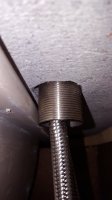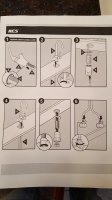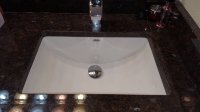View attachment 34307
I guess my questions are: Did they drill the holes based on your drawing or did you just give them the specs and tell them to make it work? Did the granite people install the piece or did you pick it up?
I've always had the granite people install and drill faucet holes on site. Even when done on site, it can be tricky. Especially with those porcelain sinks with larger/thicker flanges. In your case, it appears the faucet could not be placed too far back due to the short spout.
My buddy just did Quartz with a porcelain sink. There just wasn't much room in that strip behind the sink. He picked a large sink that barely fit in the cabinet due to the flange, the cabinet supports and the framing we had to build to carry the heavy sink. The quartz installer had a hard time getting the hole placed just right ... and the plumber b-tched anyway - but he made it work. See attached photo. We had to place the soap dispenser on the side because there was no room behind the sink for the bottle - that's how tight it was.
I've seen your situation and the haphazard solutions that didn't look pretty but they worked. I think a little ingenuity could make yours look neat and professional under the sink and work as intended. If the threaded pipe drops below the flange thickness, all you need to do is build up the bottom of the granite to the flange height so the nut rests flat. A shaped pice of wood along with a large washer would work. A stack of plastic or steel washers withe edge cut off would work.
In short. I would work around the problem even if it was the granite fabricator's fault. It would be wasteful to throw that granite in the trash.
Another buddy replaced his old granite and wanted to keep his big black ugly heavy porcelain sink that was rigged with wood shims for for the same problem you have. In his case, the sink was made to over mount or undermount. It was undermount so the hole need to match the factory holes in the flange - bu they missed apparently. So they shimmed. It looked like crap if you stuck your head up under the sink but it worked. I talked him in to letting the new granite people provide a nice new stainless sink.




